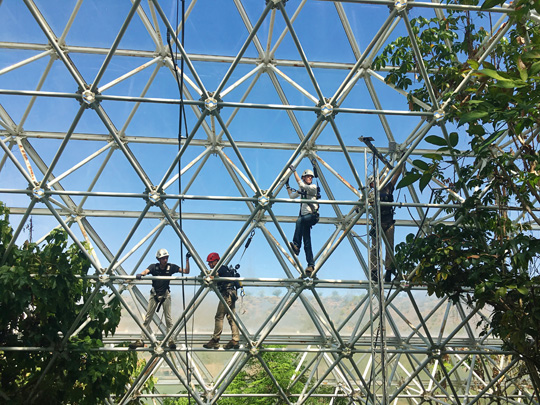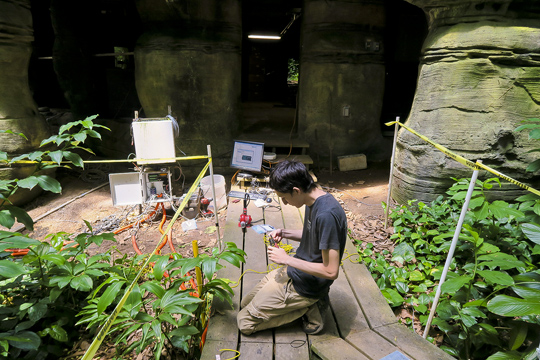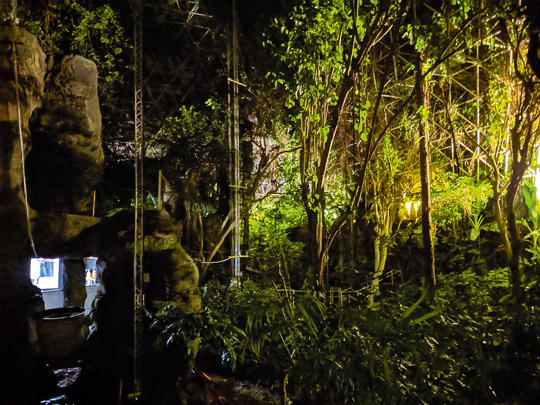Drought in Biosphere 2
Freiburg, Jan 15, 2020
Beneath the glass dome of the research facility Biosphere 2, a team from the University of Freiburg has been working for several months on the project “WALD – Water Atmosphere And Life Dynamics.” The researchers mark each individual plant in the tropical rainforest biome there and connect it to test equipment – before finally turning the water off. This allows the scientists to observe how the molecules within the plants move, even in a state of stress. Their goal is to answer an important question: What happens when it no longer rains in a rainforest?

In Arizona/USA a rainforest has been growing beneath a glass dome for 30 years. A team from Freiburg is investigating how plants process molecules during their metabolism. Photo: B2 Forest/Biosphere 2
Prof. Dr. Christiane Werner has gone without perfume, deodorant, hairspray, and sunscreen for weeks – as has everyone else in her team. The reason for this minimalism is scientific, because these products contain volatile substances that can distort important measurements. These measurements are being conducted in a complex Werner calls “little Earth”: a research station by the name of “Biosphere 2” in the middle of Arizona, USA, with a concrete foundation and a gigantic dome. A tropical forest, complete with rivers and a waterfall, has been growing here for 30 years. The trees have reached a height of 25 meters. The scientists’ base station is located in a small artificial hill in the middle of the rain forest. The forest has been allowed to develop almost without human interference of any kind in the past decades. The vegetation, soil formation processes, and microbiology have been left untouched and now form a self-contained ecosystem. “We have an ideal mix of laboratory and field,” says Werner, who teaches and researches at the University of Freiburg’s Institute of Forest Sciences. She is interested in how plants metabolize different molecules and how this process influences ecosystems. But Werner does not look at the plants only in their normal state but also and especially in situations where they are under stress from extreme climatic conditions like drought or frost.
Consequences of Drought
The scientists can simulate these conditions at Biosphere 2. Werner and her team have just spent four months investigating what consequences prolonged drought has on the vegetation. They drained the waterfall and river, thus depriving the plants of their means of survival. Then they turned back on the water supply in Biosphere 2, planning and documenting the process in great detail. For the entire course of the experiment, the researchers tracked changes in variables like atmosphere, fresh air content, and temperature. The Freiburg professor is coordinating the project together with her assistant Dr. Nemiah Ladd and with Dr. Laura Meredith from the University of Arizona, the director of the tropical rain forest at Biosphere 2. Altogether, the B2 WALD project team includes 82 researchers, from graduate students to tenured professors, from 20 research groups and 13 departments in Germany, the USA, Switzerland, Austria, and Scotland. “WALD” is an acronym for “water, atmosphere, and live dynamics.” Werner is funding her research with a Consolidator Grant from the European Research Council that she received in 2015. The infrastructure, technicians, and accommodations are being provided by Biosphere 2.

Each plant is connected to the experimental equipment. In this way, the researchers obtain results in real time. Photo: B2 Forest/Biosphere 2
Interaction between Plants
The Freiburg group in the B2 WALD project is focusing particularly on so-called biogenic volatile organic compounds, BVOC for short. “Plants do not just exchange carbon dioxide and steam but also emit such volatile compounds into the atmosphere,” says Werner. “We assume that they provide plants with certain protective mechanisms and serve as a kind of signal in the atmospheric chemistry that facilitates communication between the plants.” The scientists are tying to find out how individual plants interact and communicate with each other – presumably by way of their leaves, roots, and the soil microbiology. In the process, they have made several surprising discoveries. Roots emit BVOCs, for example, but these compounds cannot be found to the same extent in the soil or in the atmosphere. “This suggests that the soil microbes profit from the BVOCs and use them, for instance as a source of energy,” says Werner. So what, exactly, goes on in this rhizosphere, as the up to four-millimeter-wide zone of soil around a living root is called? Do the plants warn each other of threats? Do they pass on information, for instance letting them know water reserves are low and that they need to start conserving water immediately?
Scientific Detective Game
According to Werner, the effect of drought on forests is already known in a very general sense. “We in Germany experienced that very clearly just last year.” What scientists do not yet understand very well, however, are the interactions and communication processes. But that isn’t surprising when one considers just how complex every ecosystem is, says Werner. “You have to keep in mind that every little change, every tiny adjustment to the system automatically entails numerous interactions.” What is the cause and what the effect, how are individual processes organized, what does a change in the soil have to do with new conditions in the atmosphere? Fitting countless little details like these into the big picture is a detective game the professor loves to play: “I want to not just describe but explain which components are responsible for doing what.”

Measurements with water supply and during drought: The plants are examined not only in their normal state but also in situations where they are stressed by extreme climatic conditions. Photo: B2 Forest/Biosphere 2
Real-Time Observations
The basis for this work is partly technological in nature. Werner and her colleagues had 20 high-tech instruments shipped to the USA to collect data at the one-of-a-kind research complex. The team uses devices like laser and mass spectrographs to follow in real time what route individual atoms, BVOCs, and carbon dioxide molecules take in the plants. The scientists can observe by the minute and hour how trees and shrubs in Biosphere 2 respond to changed conditions. “Everyone gets excited about it,” says Werner. The technology also enables the research team to follow the results of so-called isotope labeling in real time. This method involves marking water and carbon dioxide so that their movements can be followed within the ecosystem. For this purpose, the researchers first hermetically sealed the forest and then blew marked carbon dioxide into the air in the morning. The carbon dioxide was absorbed into the leaves and the BVOCs within a short period of time, and the researchers could watch how it was led along the tree trunks from the crown to the ground. At the end of the drought, they repeated the experiment with twice the amount of marked CO2. Stable isotope marking can be used for long-term experiments too. For example, in the coming years the team will be analyzing how long the carbon remains stable in the soil. After the artificially induced drought, Biosphere 2 was irrigated again from below. This allows the researchers to determine how important deep-rooting plants and trees are for the ecosystem.
Influence on the Ecosystem as a Whole
Another exciting aspect is diversity. “It is evidently the case that the more diverse a forest is, the better it is at buffering its responses – meaning that it can cope better with changes in the ecosystem than a homogeneous forest,” explains Werner. Determining what influence various species have on the flow of the ecosystem as a whole is one of the future tasks awaiting the scientists. But this and many other questions will have to remain unanswered for a while yet, because as long as the experiment with “little Earth” is running, the participants need to devote their full concentration to measuring everything they can, compiling data, observing, and taking samples. All of this data will be analyzed later on. But in the meantime, the researchers have plenty to keep them busy: Air conditioners break down, equipment fails, and there have also been repeated problems with clogging in the four kilometers of Teflon tubing laid throughout the Biosphere 2 forest. “Coordinating this project is an enormous challenge. I’m constantly occupied with all manner of small tasks and organizational matters, because there’s always something to set straight somewhere,” says the Freiburg professor. And to explain why she is enthusiastic about the project all the same, she adds immediately: “I’ve never seen such a crazy experiment anywhere else.”
Claudia Füßler
Biosphere 2 on Instagram and Christiane Werner‘s research on Twitter

